Insulating water tanks and pipes
One result of laying insulation in the loft is that the loft itself will get colder. Tanks and pipes in the loft will be more liable to freeze in cold weather, so they must be insulated.
All cold storage tanks in the loft, including central heating expansion tanks, and all water pipes, including overflows, must be insulated. Do not insulate the floor of the loft under the tanks, heat coming up from the area below should help prevent the tanks freezing. The recommended thicknesses of tank and pipe insulation is at least 50mm (2 in) in the UK.
Insulating water pipes in the loft
All water pipes in the loft (including overflows) should be insulated. The only exceptions are those pipes that are within or under the loft insulation or within the tank casing.
Two basic options are available:
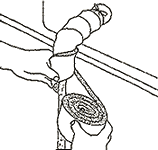 Mineral
wool mat, this is wrapped like a bandage around the pipes and secured with tape or string.
Mineral
wool mat, this is wrapped like a bandage around the pipes and secured with tape or string.
The pipes must be completely covered with no gaps.
The bodies of taps and stopcocks must also be wrapped in insulation.
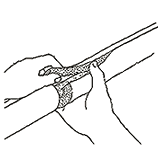 Pre-formed moulded insulation form. This is available to suit different sizes of pipes and special formed sections are available for taps and stopcocks.
Pre-formed moulded insulation form. This is available to suit different sizes of pipes and special formed sections are available for taps and stopcocks.
The moulding can be cut (using a fine toothed saw) at 45 degrees (or other angles) so that two pieces cover any bend. The internal channel may need to be shaped, using a crafting knife, so that the sections close over a sharp bend.
When installed, the sections of insulation should be taped together to ensure that the sections fully close around the pipes and are tightly butted up to one another.
Insulating hot-water tanks.
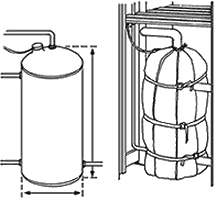 For circular tanks, insulation jackets are available in a range of standard sizes. The sizes are measured by the vertical height of the tank to the top of the dome and the overall diameter, so that you buy the correct size jacket. Two common sizes are 900mm x 450mm and 1050mm x 450mm.
For circular tanks, insulation jackets are available in a range of standard sizes. The sizes are measured by the vertical height of the tank to the top of the dome and the overall diameter, so that you buy the correct size jacket. Two common sizes are 900mm x 450mm and 1050mm x 450mm.
Most cylinder jackets are made up of a number of segments held together by a cord tied around the top of the cylinder and a number of 'belts' around the tank. Follow the manufacturer's instructions for fixing the jacket. Smooth the jacket down over the cylinder but do not apply excessive pressure as this can compress and reduce the effectiveness of the insulation. Wrap one of the belts around the jacket, close to the top, and fasten it loosely. Fasten the second belt lightly near the bottom of the tank. If there is a third belt fasten it round the middle. Make sure that the segments fully cover the tank with no gaps.
If an electric immersion heater is fitted, ensure that the cap and electric cables are not covered.
If the hot-water tank is being used to heat an airing cupboard, any insulation will reduce the heating effect. Any uninsulated pipes connecting to the tank in the cupboard will release some heat, otherwise, if a cylinder jacket is fitted, the segments can be slightly opened to allow additional heat into the cupboard.
Replacement cylinders are available with factory applied foam insulation, these are more effective than an insulating jacket so should be installed if it is necessary to fit a new cylinder for any reason.
Insulating cold water tanks in the loft
Any water tank in the loft should in insulated around the sides and on the top. The insulation around the sides must extend down to the insulation on the floor of the loft.
Some water tanks in the loft will include an overflow return (a pipe from the rest of the system bent over the top of the tank so that any excess water will vent back into the tank). Provision must be made for the overflow to feed back into the tank; this is usually achieved by a funnel contraption fitted through the top cover of the tank.
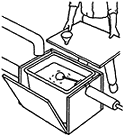 Insulating with board - The recommended thickness is 50mm (2 in). Pre-cut packs of sheet insulation material are available to fit around standard sizes of water tank.
Insulating with board - The recommended thickness is 50mm (2 in). Pre-cut packs of sheet insulation material are available to fit around standard sizes of water tank.
Alternatively insulation sheets can be cut to suit individual tanks.
The insulating board should not be fitted directly over the top of the tank, a simple, tight fitting, wooden cover should be first fitted across the top of the tank.
Carefully measure the position of any overflow feeding into the tank and fit a suitable connector through the insulation and top cover to suit.
Secure the side panels with string or tape. The top panel will probably not need to be secured to the cover.
Ensure that the cover and top panel are arranged so that the ballcock can be accessed without having to disturb the side insulation panels.
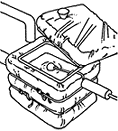 Insulation jackets -Insulation jackets are available to fit around standard sizes of tank; for a non-standard tank, a larger jacket will need to be used.
Insulation jackets -Insulation jackets are available to fit around standard sizes of tank; for a non-standard tank, a larger jacket will need to be used.
The insulating jacket should not be fitted directly over the top of the tank; a simple, tight fitting, wooden cover should be first fitted across the top of the tank.
Carefully measure the position of any overflow feeding into the tank and fit a suitable connector through the insulation and top cover to suit.
Loosely secure the sides of the jacket to the tank with string or tape. The top panel will probably not need to be secured to the cover.
Ensure that the cover and top panel are arranged so that the ballcock can be accessed without having to disturb the side insulation jacket.
All pipes entering the tank (and the overflow) must be insulated up to the tank insulation so that there are not gaps.
Make sure that the tank insulation fits down to the floor of the loft, if necessary, insulating fibre matting can be secured around the base of the tank to fill any gap.
